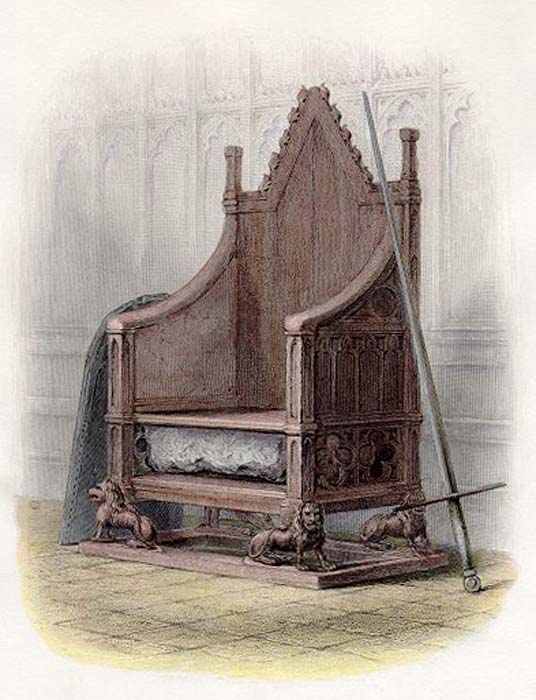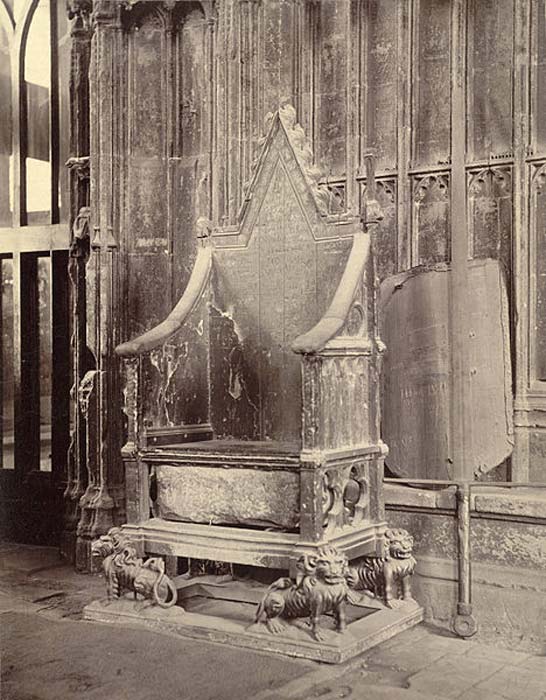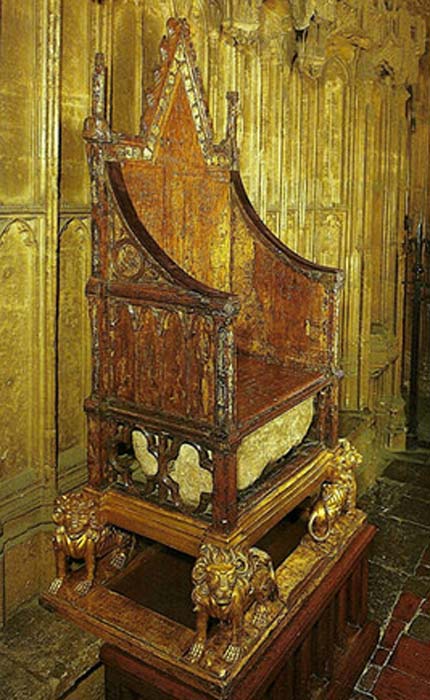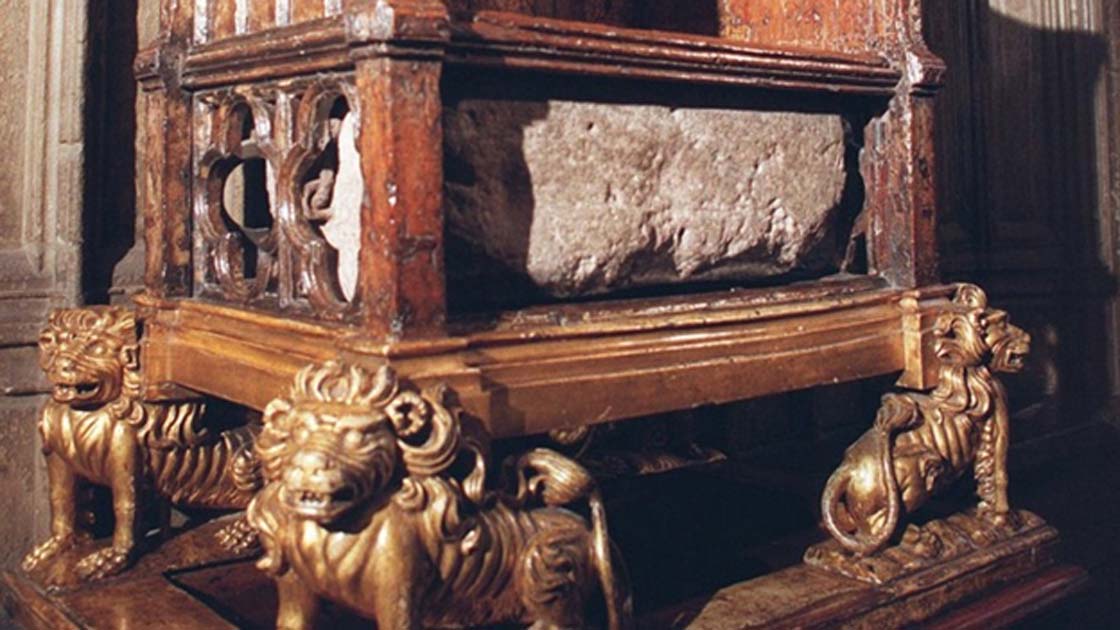The Voice is Mightier than the Sword: The Stone of Scone That Roared with Power
"Unless the fates be faulty grown
And prophet’s voice be vain
Where’er is found this sacred stone
The Scottish race shall reign."
-translated by Sir Walter Scott, 16th century
A stone valued more for its voice than its build, the Stone of Scone has long played a significant role in the crowning of the kings of Ireland, Scotland, and England. Though the stone has had different loyalties prior to the unification of Northern Ireland, Scotland, England, and Wales into the United Kingdom, it has always stood as a pillar of power and birthright. Without its presence, the rulers of ancient Ireland, the medieval land of the Scots, and presently the United Kingdom, were not deemed legitimate rulers. Its voice rather silent now, the Stone of Scone's mere presence holds more power than rulership dictated in script.

The Stone of Scone in the Coronation Chair at Westminster Abbey. Published in ‘A History of England.’ (1855) (Public Domain)
Mythological Legends of the Stone of Scone
The Stone of Scone has various mythological legends of its existence. One of the most famous is that the stone is the same as Lia Fáil, the Stone of Destiny, brought to Ireland by the magical Tuatha de Danann thousands of years ago. Lia Fáil was the coronation stone of the High Kings of Ireland, situated at the center of the royal complex at Tara in County Dublin. While there is a stone in the place where Lia Fáil stood all those years ago, some believe that this is in fact a replica, and that the original was taken to Scotland to serve as the coronation rock at Scone for the kings of the Scots.
- Thrones of Gods and Kings: Symbols of Power through History
- Legendary Lia Fáil - The Coronation of High Kings in Ancient Ireland
- Kenneth MacAlpin: King of the Picts and Legendary Founder of Scotia

Riders of the Sidhe. (1911) John Duncan. This is an imaginary representation of what the famous Irish ‘fairy people’ the Tuatha Dé Dannan, may have looked like. (Public Domain)
Because of the conflicting accounts of whether or not the Stone of Scone and Lia Fáil are the same rock, it is hard to separate one mythological legend from another. The recounting of the Lia Fáil's removal from Tara to be placed at Scone is believed to be entirely the work of Scottish writers who claim Fergus Mór mac Eirc (Fergus Mór, son of Erc) was responsible for moving the stone from Tara in Ireland to Scone, Scotland, for his coronation as the first King of the Scots in the 5th century AD.
Due to the reuse of the stone, it should be noted that while the stone was renamed for its new location, its mystical hand in royal coronation remained the same. Lia Fáil served as indicator of the rightful king of the land, whether that land was Tara or the land of the Scots, the stone was said to "roar with joy" as the feet of the chosen king passed over it during a ritual leaping test. This test is precisely what it sounds like: the rightful king was able to successfully leap over the large stone pillar without injury or mistake. As he did so, the stone was said to acknowledge the new king's power.

The Stone of Destiny, Lia Fáil, found on the Hill of Tara in Ireland. (Verdasuno/CC BY SA 3.0)
Modern Importance of the Stone of Scone
Further, because Ireland, Scotland, and England were not divided as they are now in the ancient Isles, it is not without merit to postulate that the stone is among as many tribal descendants in Scotland as it was in the Ireland of the Tuatha de Danann. The mystical power of the stone remains strong to the royal family and constituents of the British Isles as a coronation is not properly completed without the Stone of Scone's presence.

Coronation Chair with Stone of Scone, Westminster Abbey. (The Commons)
From the moment Fergus and his men set the stone in Scone, the rock remained in Argyll until it was taken by King Edward I of England in 1296, and fitted into the coronation chair of Edward at Westminster Abbey. This is where the Stone of Scone remained until 1950. At that point, Scottish student nationalists—likely as brave and reckless as the Scottish warriors in Fergus Mór's clan—stole the stone away from Westminster to return it to Scotland.
- Witchcraft? Tributes to Murder Victims? The Uncertain Origins of 17 Miniature Coffins in Scotland
- Archaeologists Say They Have Found an Important Medieval Site Linked to Scottish Hero William Wallace
- Cannibalism in Scotland: The Dark Legend of Sawney Bean
By 1996, the Stone of Scone—repaired after the students accidentally broke it in half during their "covert" operation–was returned to Scotland, where it remains in the Crown Room at Edinburgh Castle. As one might guess, the roaring myth faded once the stone was secured under the chair at Westminster Abbey—and then in the Crown Room at Edinburgh—however, the symbolism remains the same. Further, upon the next coronation of a British royal, the stone will briefly be taken to Westminster for the ceremony, before returning to its permanent home.

Replica of the Stone of Scone at the original location at Scone Palace, Scotland. (CC BY SA 3.0)
It is often said that "the pen is mightier than the sword," but there is something to be said for the voice. While the pen can write lies or truth for permanent shame or power, the Stone of Scone was once believed to vouch for Scottish rulers so powerfully that its proclamation was heard throughout the land. As the stone remains a necessary participant for the rightful coronation of British leaders, that voice still holds far more value than any other weapon in ancient or modern history.

King Edward’s Chair, also known as the Coronation Chair, with the Stone of Scone. (Nathan Hughes Hamilton/CC BY 2.0)
Top Image: The Stone of Scone. Source: Imelde Corelli Gioielli
By Ryan Stone
Bibliography
Editors of Encyclopedia Britannica. "Stone of Scone." Encyclopedia Britannica. Accessed July 23, 2017. https://www.britannica.com/topic/Stone-of-Scone
Ellis, Peter Berresford. 2002. Celtic Myths and Legends. Running Press: PA.
Gantz, Jeffrey. 1982. Early Irish Myths and Sagas. Penguin Classics: UK.
Gregory, Lady Augusta. 2014. Lady Gregory's Complete Irish Mythology. Bounty Books: UK.
Hamilton, Ian R. 1992. Taking the Stone of Destiny. Seven Hills Book Distributors: Cincinnati.
Historic Environment Scotland. "The Stone of Destiny." Edinburgh Castle. Accessed July 22, 2017. https://www.edinburghcastle.gov.uk/discover/highlights/the-stone-of-destiny
Johnson, Ben. "The Stone of Destiny." Historic UK. Accessed July 21, 2017. http://www.historic-uk.com/HistoryUK/HistoryofScotland/The-Stone-of-Destiny/
"The Stone of Destiny." English Monarchs. Accessed July 21, 2017. http://www.englishmonarchs.co.uk/stone_scone.html
Visit Scotland. 2017. "Honours of Scotland and the Stone of Destiny." Accessed July 23, 2017. https://www.visitscotland.com/about/uniquely-scottish/honours-scotland-stone-destiny/
Woolf, Alex. 2007. From Pictland to Alba, 789-1070 (New Edinburgh History Scotland.) Edinburgh University Press: Edinburgh.


















Comments
I will overturn, overturn, overturn..... (Ezekiel 21:27 KJV). The stones are one and the same. "Jacob's Pillar Stone" left Jerusalem when King Zedekiah, the last monarch in Jerusalem was killed. It went to Ireland. First overturn. It then left Ireland and went to Scotland. Second overturn. And finally to England. Third overturn. The next and last kingdom to receive it will be the Kingdom of God. Jesus (Joshuah) will sit on the David's throne with the stone beneath.